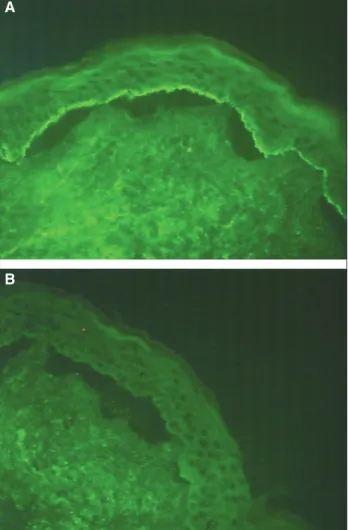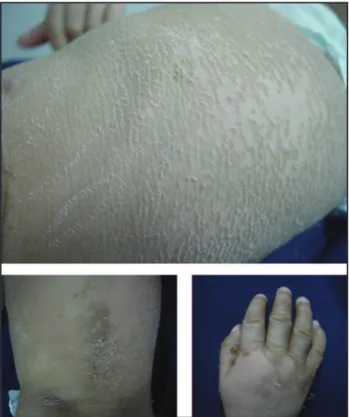412
EJD, vol. 21, n◦3, May-June 2011 AB
Figure 1.IIF using 1 mol/L NaCl split normal human skin as a substrate.
autoantigen of LABD by immunoblot studies in only a few reports [4, 5].
The major target antigen in LABD is LAD-1, a protein of 120 k-Da, which is a proteolytic fragment of the extracellu-lar domain of BP180 as a result of its cleavage on the surface of keratinocytes by the action of an enzyme. This enzyme belongs to the family of ADAMTS (A disintegrin and A metalloprotease). The other well known antigen is a 97 k-Da protein which is a fragment of the 120 k-k-Da protein [6]. In our immunoblot analysis, we also found autoantibodies reactive with a 97 k-Da protein, but less reactive.
In this case, we report the novel finding of an IgA directed against a protein of 200 k-Da located on the epidermis. Zone
et al.also found a band at 200 k-Da in patient’s serum with LABD [4]. In fact, this 200 k-Da band, reactive with whole serum, was not present when the purified antibody was used. This suggested that the antibody that bound to this 200 k-Da band was not purified by the immunoaffinity process using human BMZ. These results suggested that the pres-ence of those antibodies may be just an epiphenomenon. However, Fujimotoet al.[6] showed that circulating IgA autoantibodies to 200 and 280 k-Da antigens were detected in an LABD patient’s serum by immunoblot analysis using extracts from normal human epidermis and human epi-dermal keratinocytes. These two antibodies also reacted with the epidermal side of 1 mol/L NaCl split skin on IIF
microscopy and bound to hemidesmosomes as determined by immunoperoxydase electronic microcopy. Our results may also suggest the presence of 200 k-Da hemidesmo-somal proteins as target antigens in linear IgA disease. Our observation supports the contention that LAD is a het-erogeneous disease. Further studies need to investigate if these antibodies directed toward a protein of 200 k-Da are pathogenic, where this 200 k-Da protein is situated and which protein of the BMZ is implicated in such cases.
Disclosure. Financial support: none. Conflict of interest: none.
1Department of Dermatology,
University Hospital of Brest, 2 avenue Foch,
29200 Brest, France
2Department of Pathology,
University Hospital of Brest, 2 avenue Foch,
29200 Brest, France
3Department of Immunopathology,
University Hospital of Rouen, France
<karentalour@hotmail.com>
Karen TALOUR1
Allan KARAM1
Nadège DREUX2
Gilles LEMASSON2
Daniele GILBERT3
Claire ABASQ1
Laurent MISERY1
1.Paul C, Wolkenstein P, Prost C, et al. Drug-induced linear
IgA disease: target antigens are heterogeneous. Br J Dermatol
1997; 136: 406-11.
2.Christophoridis S, Büdinger L, Borradori L, Hunziker T, Merk HF,
Hertl M. IgG, IgA and IgE autoantibodies against the ectodomain of BP180 in patients with bullous and cicatricial pemphigoid and linear IgA bullous dermatosis. Br J Dermatol2000; 143: 349-55.
3.Jonkman MF, Groot AC, Slegers TP, Jong MC, Pas HH. Immune
diagnosis of pure ocular mucous membrane pemphigoid: indirect immunofluorescenceversusimmunoblot.Eur J Dermatol2009 ; 456-60.
4.Zone JJ, Taylor TB, Kadunce DP,et al. IgA antibodies in chronic
bullous disease of childhood react with 97 kDa basement membrane zone protein. J Invest Dermatol1996; 106: 1277-80.
5.Zhou S, Ferguson DJ, Allen J, Wojnarowska F. The localization of
target antigens and autoantibodies in linear IgA disease is variable: correlation of immunogold electron microscopy and immunoblotting. Br J Dermatol1998; 139: 591-7.
6.Fujimoto W, Ohtsu T, Toi Y, Nakanishi G, Arata J. Linear IgA
disease with IgA antibodies directed against 200- and 280-kDa epi-dermal antigens. Br J Dermatol2000; 142: 1213-8.
doi:10.1684/ejd.2011.1283
Sjögren-Larsson syndrome due to a novel
mutation in the FALDH gene
EJD, vol. 21, n◦3, May-June 2011
413
[3-5]. The genotype of SLS patients varies considerably,with many private mutations in individual patients [4, 5]. We report a 2.5-year-old girl presenting with a history of generalized extremely dry and scaly skin since birth. Her mental and motor development was also delayed; she had spastic diplegia of the legs and expressed herself only in monosyllables. She had been born at gestational week 35, after a normal pregnancy with no antenatal or perinatal complications. There was no history suggestive of a colloidion membrane at the time of birth. Family history showed consanguinity, the parents were second degree cousins, but there were no other relatives with SLS. Gradually the skin lesions worsened, becoming thicker, especially over the flexures, with some lichenified hyperkeratosis (figure 1).The lesions were very pruritic. Scaling and hyperlinearity of palms and soles was present. Ophthalmological and otorhinolaryngological examination was normal.
Magnetic resonance imaging of the brain revealed unmyelinated white matter, and the proton spectroscopy demonstrated an abnormal white matter peak at 1.3 ppm. Histopathologic examination showed orthohyperkeratosis, acanthosis and papillomatosis. Genetic analysis of the patient detected a delection of thymidine at position 805 of the exon 6 [c.805delT (p.Tyr269fsX5)] of the FALDH gene in a homozygous state. The same mutation was found in heterozygous state in both parents. This mutation has not been previously reported and functional analysis was not performed. However, as it introduces a premature stop condon, it is predicted to cause either a reduced expression of the mRNA or a truncated protein, with consequent reduc-tion of the amount of enzyme produced or loss of enzymatic function, respectively.
SLS is a chronic disabling neurocutaneous disease with autosomal recessive inheritance that was described in detail
Figure 1.Generalized dry and scaly skin.
by two Swedish psychiatrists, Sjögren and Larsson, in 1957 [1]. It is caused by mutations in the ALDH3A2 gene, how-ever the relationship between the genotype and the clini-cal phenotype of SLS has been difficult to establish [4]. The consequent accumulation of fatty aldehyde precursors, including fatty alcohols, caused by the FALDH deficiency, is postulated to affect the normal formation of multi-lamellar membranes in the stratum corneum and myelin, and to result in the symptoms [5].
The neurological features of SLS appear in the first years of life and then seem to stabilize [5]. Cerebral proton magnetic resonance spectroscopy in patients with SLS demonstrates an abnormal white matter peak at 1.3 ppm [6], consistent with long-chain fatty alcohol accumulation and coincides with retarded myelination [5].
The diagnosis of SLS is invariably delayed, similarly to other rare genodermatosis. On clinical grounds the diagnosis should be suspected in infants with congenital ichthyosis, especially with emerging neurological features. The ichthyosis is usually the first signal that brings the patient to medical attention, emphasizing the role of the dermatologist in the diagnosis. Unlike most other forms of ichthyosis, it has a disturbing pruritic character and, as in our case, patients tend to be born preterm.
To our knowledge, the mutation of our patient has not been previously reported, supporting the rich mutational hetero-geneity associated with this syndrome.
Disclosure. Financial support: none. Conflict of interest: none.
1Dermatology Department Hospital
de Braga, Apartado 2242, 4701-965 Braga, Portugal
2Casa de Sáude de Guimarães,
Guimarães, Portugal
3Neurology Department,
Hospital de Braga, Portugal
4CGC genetics,
Porto, Portugal
<gbmjoana@yahoo.com>
Joana Maria BOTELHO GOMES1
Ana Paula VIEIRA1
Jorge NAVARRO2
Ricardo MARÉ3
Purificac¸ão TAVARES4
Celeste BRITO1
1.De Laurenzi V, Rogers GR, Hamrock DJ,et al. Sjögren-Larsson
Syn-drome is caused by mutations in the fatty aldehyde dehydrogenase gene. Nat Genet1996; 12: 52-7.
2.Rizzo WB. Sjögren-Larsson syndrome. Semin Dermatol1993; 12:
210-8.
3.Auada MP, et al. Sjögren-Larsson syndrome: biochemical
defects and follow up in three cases. Eur J Dermatol 2002; 12: 263-6.
4.Auada MP, Puzzi MB, Cintra ML,et al. Sjögren-Larsson Syndrome
in Brazil is caused by a common c.1108-1G→C splice-site mutation
in the ALDH3A2 gene. Br J Dermatol2006; 154: 770-3.
5.Lassos A, Khoury M, Rizzo W, et al. Phenotypic variability
among adult siblings with Sjögren-Larsson Syndrome. Arch Neurol
2006; 63: 278-80.
6.Mano T, Ono J, Kaminaga T,et al. Proton MR Spectroscopy of
Sjögren-Larsson Syndrome. Am J Neuroradiol1999; 20: 1671-3.

